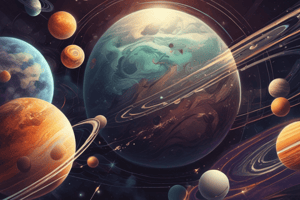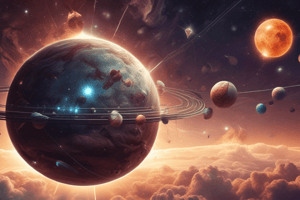Podcast
Questions and Answers
What is the estimated percentage of the Solar System's mass that is in the Sun?
What is the estimated percentage of the Solar System's mass that is in the Sun?
- 50%
- 99.86% (correct)
- 95%
- 75%
What is the main process that occurs at the core of the Sun?
What is the main process that occurs at the core of the Sun?
- Fusion of hydrogen into helium (correct)
- Fusion of helium into hydrogen
- Nuclear fission
- Radioactive decay
Which of the following planets are classified as ice giants?
Which of the following planets are classified as ice giants?
- Jupiter and Saturn
- Uranus and Neptune (correct)
- Mars and Earth
- Venus and Mercury
What is the outermost region of the Solar System?
What is the outermost region of the Solar System?
What is the classification of the Sun according to astronomers?
What is the classification of the Sun according to astronomers?
What is the region of the Solar System where the solar wind is halted?
What is the region of the Solar System where the solar wind is halted?
How many dwarf planets are recognized by astronomers in the Solar System?
How many dwarf planets are recognized by astronomers in the Solar System?
What is the characteristic of the terrestrial planets in the Solar System?
What is the characteristic of the terrestrial planets in the Solar System?
Flashcards are hidden until you start studying
Study Notes
Formation and Structure of the Solar System
- The Solar System was formed approximately 4.6 billion years ago from a dense region of a molecular cloud that collapsed, resulting in the Sun and a protoplanetary disc.
- The Sun is a G-type main-sequence star that maintains equilibrium through the fusion of hydrogen into helium in its core.
Planets in the Solar System
- There are eight planets in the Solar System, classified into three categories: terrestrial planets (Mercury, Venus, Earth, and Mars), gas giants (Jupiter and Saturn), and ice giants (Uranus and Neptune).
- Terrestrial planets have solid surfaces, while gas and ice giants do not have a definite surface due to their composition of gases and liquids.
Mass Distribution in the Solar System
- The Sun and Jupiter/Saturn account for over 99.86% and nearly 90% of the Solar System's mass, respectively.
Dwarf Planets and Small Solar System Bodies
- There are at least nine confirmed dwarf planets in the Solar System: Ceres, Orcus, Pluto, Haumea, Quaoar, Makemake, Gonggong, Eris, and Sedna.
- The Solar System also comprises various small bodies, including asteroids, comets, centaurs, meteoroids, and interplanetary dust clouds.
- The asteroid belt is located between Mars' and Jupiter's orbits, while the Kuiper belt lies just outside Neptune's orbit.
Moons and Satellites
- Six planets, seven dwarf planets, and other bodies have natural satellites, commonly referred to as 'moons'.
Boundaries and Regions of the Solar System
- The heliosphere is the region of space influenced by the Sun's charged particles, the solar wind.
- The heliopause marks the boundary of the Solar System, located around 75-90 astronomical units from the Sun.
- The theorized Oort cloud is the source of long-period comets, extending from 2,000 to 200,000 AU from the Sun.
Neighboring Stars and Galaxies
- Proxima Centauri is the closest star to the Solar System, located 4.25 light-years (269,000 AU) away.
- Both the Sun and Proxima Centauri are part of the Milky Way galaxy.
Studying That Suits You
Use AI to generate personalized quizzes and flashcards to suit your learning preferences.




